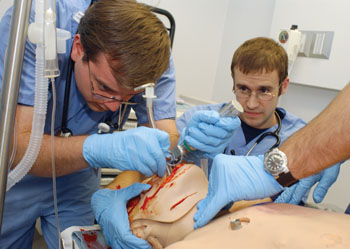
Residents Rob Wells, M.D., left, and Brandon Ramo, M.D., work together to intubate a "patient" in a simulation training session.
photo by Dana Johnson
New center takes hands-on approach to enhancing care
Vanderbilt University Medical Center is creating a new center to enhance the training of medical and nursing students, residents, faculty and staff so that patient care is optimized.
The Center for Experiential Learning and Assessment (CELA) is set to open in early 2007 and will be located in Medical Research Building IV above Langford Auditorium.
It will be home to both a new standardized patient program and a technical-based Center for Medical Simulation.
Heading the endeavor are John Shatzer Jr., Ph.D., associate professor of Medical Education and Administration and director of the Office for Teaching and Learning in Medicine, and Matthew B. Weinger, M.D., professor of Anesthesiology, Biomedical Informatics and Medical Education and director of the Vanderbilt Center for Medical Simulation and the Vanderbilt Center for Perioperative Research in Quality.
Shatzer, in addition to helping lead the school's efforts to improve medical education by providing new tools and strategies to enhance learning, define and measure outcomes and meet the demands of educational accrediting bodies, will oversee the human simulations, or the use of standardized patients for teaching and assessment.
Weinger will focus on the technical training components of the center — the human mannequin simulators, partial task trainers and virtual reality tools.
On Feb. 3, Weinger will be named the Norman Ty Smith Chair in Patient Safety and Medical Simulation, one of the nation's first endowed chairs focused on patient safety and simulation. Smith was a pioneer in medical simulation, computer modeling and medical instrumentation and was Weinger's mentor from the time he was a medical student at the University of California San Diego, where he was on faculty, until joining VUMC last year.
The event is being held in conjunction with the Advances in Patient Safety and Medical Simulation conference, to be held in the Vanderbilt Student Life Center. For more information see www.vusimcenter.org.
“Our effort is patient safety-based,” Weinger said. “If you do simulation training, medical people don't make medical errors because they're better trained before you allow them to go take care of patients. Therefore it's a safer environment.”
On the technical end, the Center for Medical Simulation offers screen-based simulation — computer-like video games for testing knowledge such as Advanced Cardiac Life Support, partial task trainers and virtual reality simulators. The center also has four adult and two pediatric physical simulators, or mannequins.
The technical-oriented Center for Medical Simulation, now located in a temporary space at Oxford House, will occupy 4,500 square feet of the new space, including a 1,100-square-foot simulation room, which can be divided into two separate simulation rooms, each with its own control room and areas for pharmacy/supply and debriefing.
Located one floor above the Center for Medical Simulation will be the 6,500-square-foot, standardized patient (SP) facility with 12 exam rooms equipped with cameras and microphones for monitoring trainees' interactions with the standardized patients.
The standardized patient (SP) program, which officially gets under way March 1, will be led by Lisa Rawn, who comes to VUMC from the Uniformed Services University of Health Sciences in Bethesda, Md. Until the new building is complete, the SP program will operate from a temporary location on the fourth floor of Medical Center North. Standardized patients are currently being recruited.
Standardized patients have been around for more than 30 years, although the program is new to Vanderbilt, Shatzer said. VUMC has been borrowing the “patients” from Meharry Medical College's program for several years. “A standardized patient is a healthy individual, perhaps a retired person or someone who works part time and wants to pick up an extra job, and who is trained to portray a patient,” he said. The individual can simulate physical findings and takes on a patient's persona — their medical, social and family history. Most medical schools maintain a pool of 75 to hundreds of standardized patients.
Shatzer said both programs will help train students, residents, faculty and staff in a rapidly-changing health care environment and will address knowledge, skills, attitudes and behaviors of students, residents, faculty and staff who participate in the learning programs offered.
“With these programs we can specify exactly what needs to be accomplished on any given day,” Shatzer said. “In most clinical experiences you catch what you can and it's completely random how students learn. The health care environment is so complex and busy and patients are much sicker when they come in. Twenty years ago, students could see a patient over a two-week period. Now patients are gone in three days and they're very busy while they're here, so it's a different environment that students are being forced to learn in.”
In a simulated environment students can reach a level of competence that allows them to function more efficiently with a real patient, Weinger said.
Shatzer said the SP program, in particular, will help address a critical problem in health care — the failure to communicate. “Traditionally we've taught medical and nursing students, especially medical students, that health care is an individual sport and all they have to do is learn all this knowledge and skills.”
Weinger said improving communication is key. “When you look at why patients are harmed in health care settings, failure of communication is the number one contributory factor to adverse events,” he said. “We view simulation as a continuum that allows us to address the four elements of knowledge, skills, attitudes and behaviors with a critical emphasis on interpersonal and team communication.”













